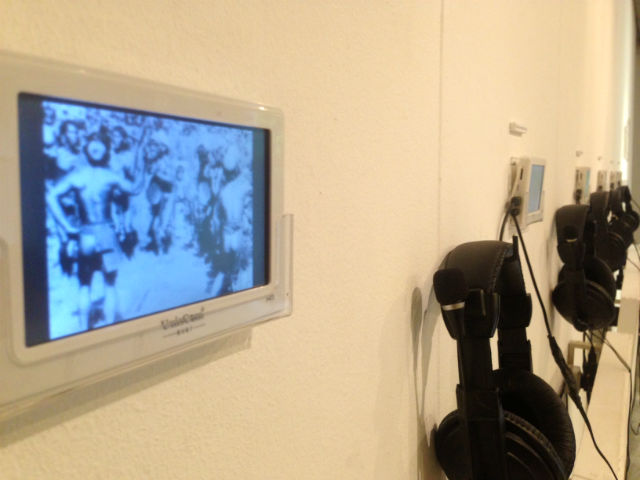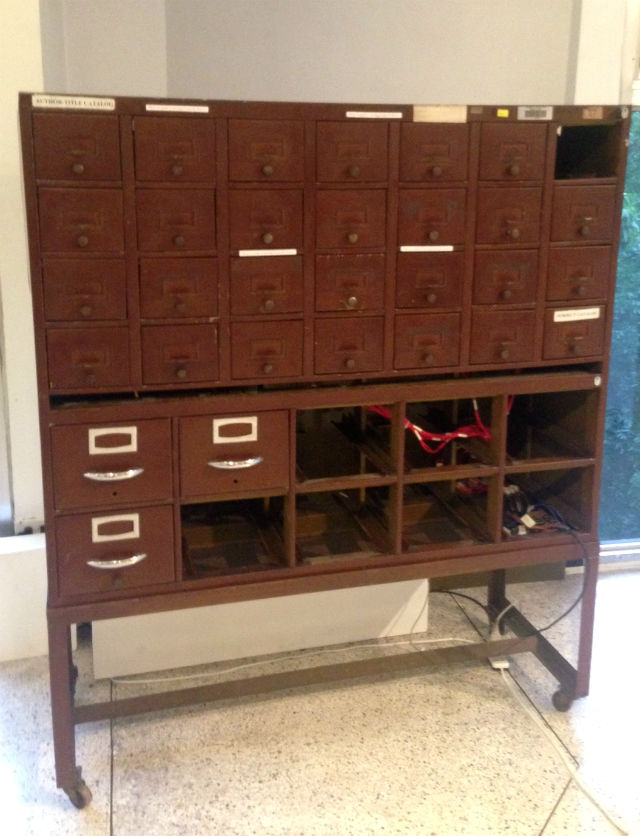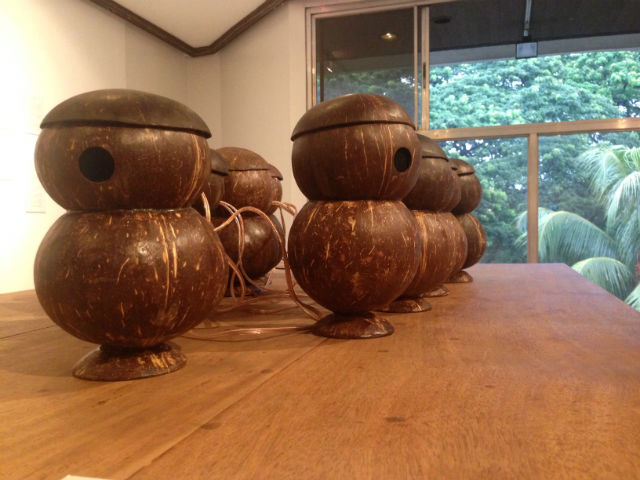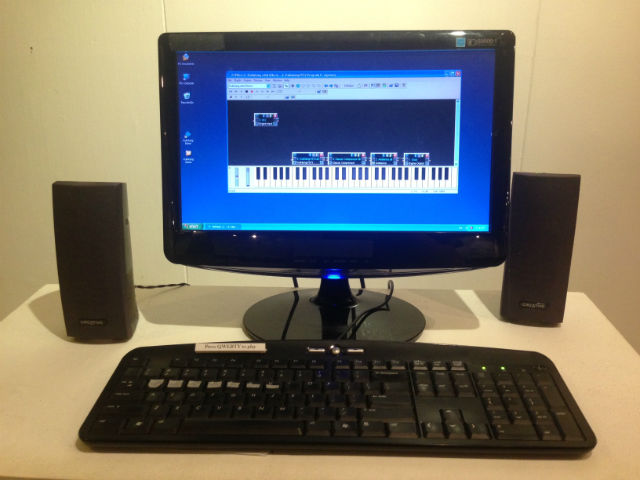ADVERTISEMENT
Filtered By: Lifestyle
Lifestyle
Interactive exhibit explores the world of avant-garde composer Jose Maceda
By CARMELA G. LAPEÑA, GMA News

A row of headphones hanging on one wall allows a sampling of various pieces that pay tribute to Maceda. Photos by Carmela G. Lapeña
At first, the "Maceda Project 2013: Listen to My Music" feels like stepping inside an empty church.
It is quiet, but upon closer inspection, the exhibit is bursting with sound. In one corner, a card catalogue cabinet is a treasure trove of 30 sounds. Instead of a list of books, the drawers contain sounds from the Maceda ethnomusicology archive, which includes gongs, bamboo flutes, voices, and drums.
When one opens a drawer, a single sound is released. Up to 12 drawers can be opened at a time, allowing for 1,152,000 sound mixes, the exhibit notes explained.
On a table, tunog ng baong niyog — coconut sounds — are heard through speakers, invisible as they are embedded in an assemblage of repurposed coconut shells.
"30 Sounds in a Filing Cabinet" is Tengal Drilon's reaction to Maceda's concept of blurred melody. "The instruments and music parts I chose were specific to Maceda's idea of writing music for many performers, except in this case, it is for one performer," he wrote.

"30 Sounds in a Filing Cabinet" by Tengal Drilon
Meanwhile, the coconut sounds are Cris Garcimo's "Niyogan - Cocospheres: Sounds from the Coconut Village," which the exhibit notes explain are a celebration of Maceda's journey into the village culture and its musical manifestation.
A row of headphones hanging on one wall allows a sampling of various pieces that pay tribute to Maceda. In "Suling-Suling," Paolo Garcia reworks the classical Maceda composition with modern technology and electronics. In "Ugnayan," Malek Lopez blends the original recording — 51 minutes of music split into 20 radio stations — with sounds of the city.
 Maceda, who died in 2004, had an extensive collection of music, including 23 compositions and music that he gathered from over 100 ethnic groups, from mountain villages to island communities.
Maceda, who died in 2004, had an extensive collection of music, including 23 compositions and music that he gathered from over 100 ethnic groups, from mountain villages to island communities.
To put up a comprehensive exhibit on Maceda as composer, musicologist, teacher and performer would require a great deal of time and space. "To search the nooks and crevices of 'The Maceda' is much bigger than the physical volume of UP Center for Ethnomusicology's collection. It is horrifyingly massive," curator Dayang Yraola wrote.
As it was, a whole afternoon would not be enough to fully explore the exhibit, not that one notices time while experiencing the pieces. The headphones shut everything out, at the same time drawing one into the fascinating world of sound.
In the exhibit, there is the shared experience of listening to Maceda's music and the pieces it inspired. However, each experience is also unique. Visitors are invited to interact by making their own music with projects such as the Kulintang Midi by Franchesca Laguna and Nicanor Marco Valdez, as well as interactive media art such as Sammy and the Sandworms by Tad Ermitaño.
The latter, based on the work of Golan Levin, allows the interactor to draw lines on a computer screen, which then crawl away like worms, sounding a note as they move across the screen. Ermitaño explained that the work is aligned with Maceda's music in its "willingness to abandon the obvious beat or pulse," and in the "creation of 'sonic mosaics' by combining different timbres."
 Visitors are allowed a deeper look into the world of the avant-garde composer through a selection of photographs, field audio recordings, and field notes. Inside the archive gallery, the smell of old paper fills the space where Maceda's old tape recorders are on display.
Visitors are allowed a deeper look into the world of the avant-garde composer through a selection of photographs, field audio recordings, and field notes. Inside the archive gallery, the smell of old paper fills the space where Maceda's old tape recorders are on display.
In a separate room, one can listen to 12 of Maceda's compositions, as well as view videos by Egay Navarro and Rica Concepcion.
One leaves the exhibit both satisfied and curious to know more, or rather, hear more of Maceda. In his own words, "The man behind the music does not matter. If you want to honor me, listen to my music." — BM, GMA News
Held by the University of the Philippines Center for Ethnomusicology as part of its Foundation's 16th Anniversary, the "Maceda Project 2013: Listen to My Music" will be on exhibit at the UP Vargas Museum until July 26.
A row of headphones hanging on one wall allows a sampling of various pieces that pay tribute to Maceda. In "Suling-Suling," Paolo Garcia reworks the classical Maceda composition with modern technology and electronics. In "Ugnayan," Malek Lopez blends the original recording — 51 minutes of music split into 20 radio stations — with sounds of the city.

Cris Garcimo's "Niyogan - Cocospheres: Sounds from the Coconut Village."
To put up a comprehensive exhibit on Maceda as composer, musicologist, teacher and performer would require a great deal of time and space. "To search the nooks and crevices of 'The Maceda' is much bigger than the physical volume of UP Center for Ethnomusicology's collection. It is horrifyingly massive," curator Dayang Yraola wrote.
As it was, a whole afternoon would not be enough to fully explore the exhibit, not that one notices time while experiencing the pieces. The headphones shut everything out, at the same time drawing one into the fascinating world of sound.
In the exhibit, there is the shared experience of listening to Maceda's music and the pieces it inspired. However, each experience is also unique. Visitors are invited to interact by making their own music with projects such as the Kulintang Midi by Franchesca Laguna and Nicanor Marco Valdez, as well as interactive media art such as Sammy and the Sandworms by Tad Ermitaño.
The latter, based on the work of Golan Levin, allows the interactor to draw lines on a computer screen, which then crawl away like worms, sounding a note as they move across the screen. Ermitaño explained that the work is aligned with Maceda's music in its "willingness to abandon the obvious beat or pulse," and in the "creation of 'sonic mosaics' by combining different timbres."

Kulintang Midi by Franchesca Laguna and Nicanor Marco Valdez
In a separate room, one can listen to 12 of Maceda's compositions, as well as view videos by Egay Navarro and Rica Concepcion.
One leaves the exhibit both satisfied and curious to know more, or rather, hear more of Maceda. In his own words, "The man behind the music does not matter. If you want to honor me, listen to my music." — BM, GMA News
Held by the University of the Philippines Center for Ethnomusicology as part of its Foundation's 16th Anniversary, the "Maceda Project 2013: Listen to My Music" will be on exhibit at the UP Vargas Museum until July 26.
More Videos
Most Popular




